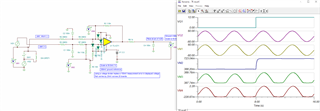Other Parts Discussed in Thread: TLV9151
Hi,
I have a TINA simulation of the TLV271 in a differential amplifier configuration. The simulation worked well however the actual circuit does not. It appears that the simulation generates invalid output when the input pins are driven below the negative supply rail. TINA file attached.




